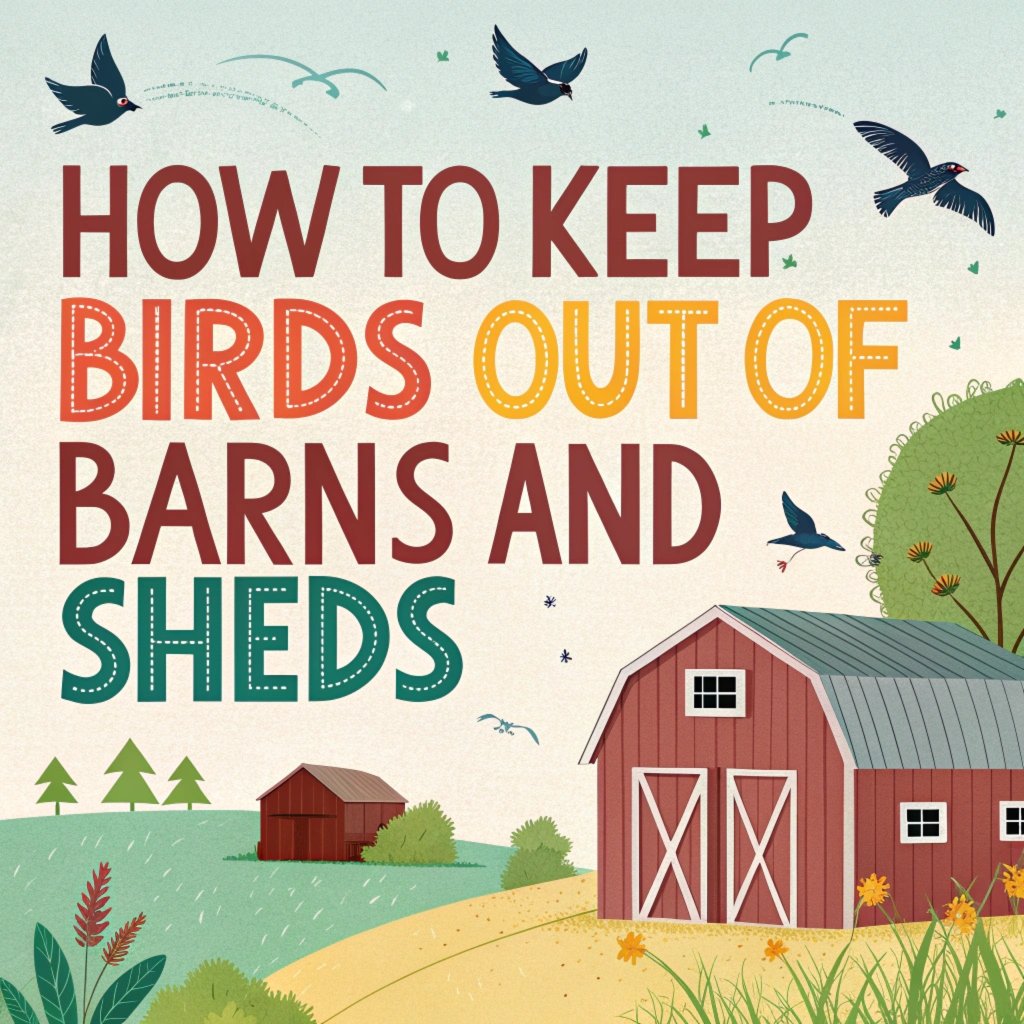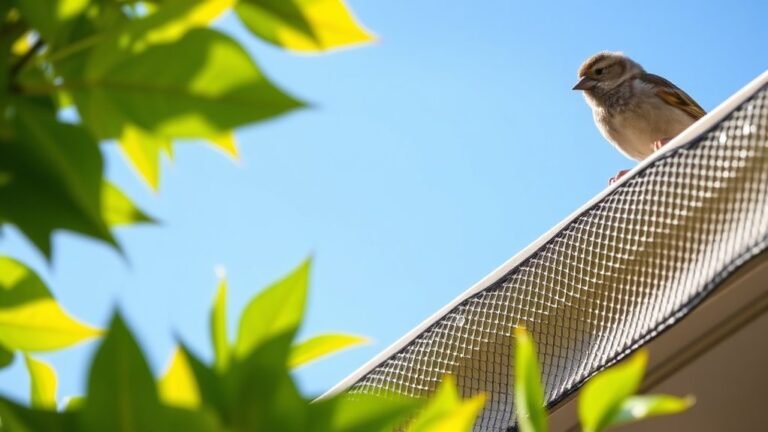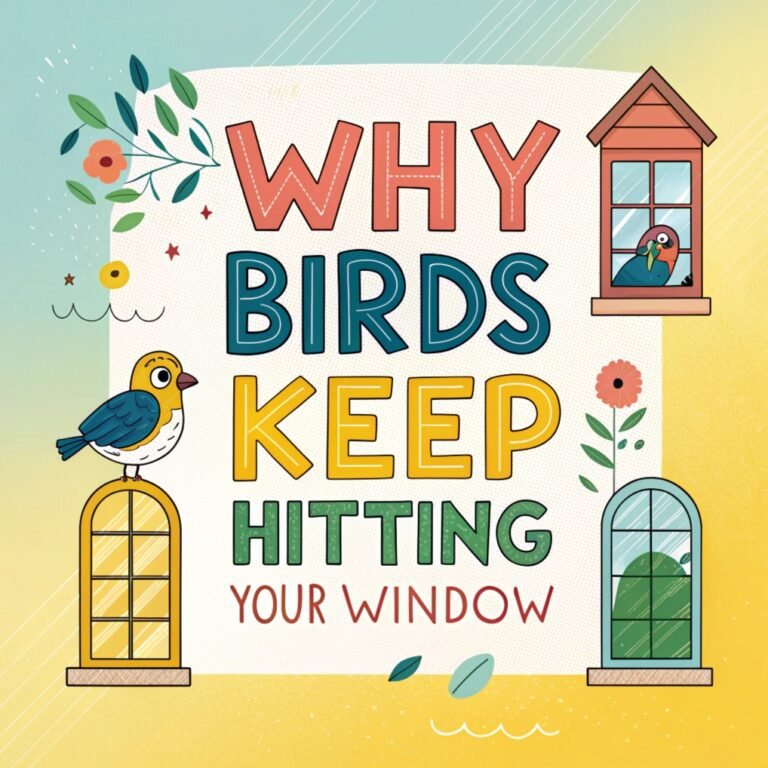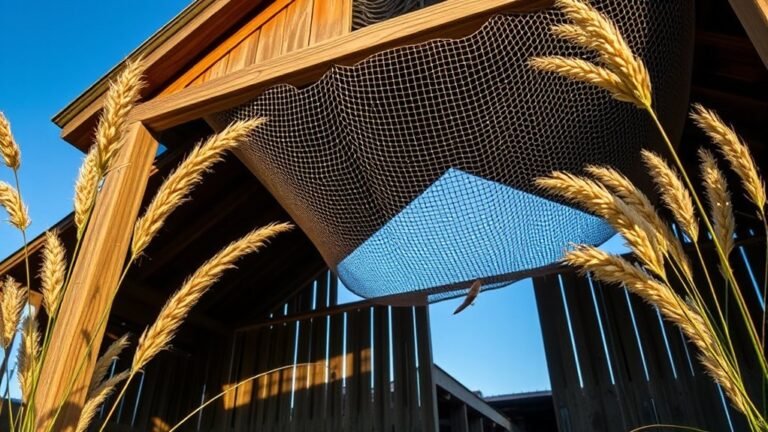How to Keep Birds Out of Barns and Sheds: A Comprehensive Guide
Birds can be a significant nuisance when they invade barns, sheds, and other structures.
These unwelcome visitors not only cause damage to property but also pose potential health risks.
Whether you’re dealing with persistent pigeons, sneaky sparrows, or stubborn starlings, keeping these feathered intruders at bay requires a multi-faceted approach.
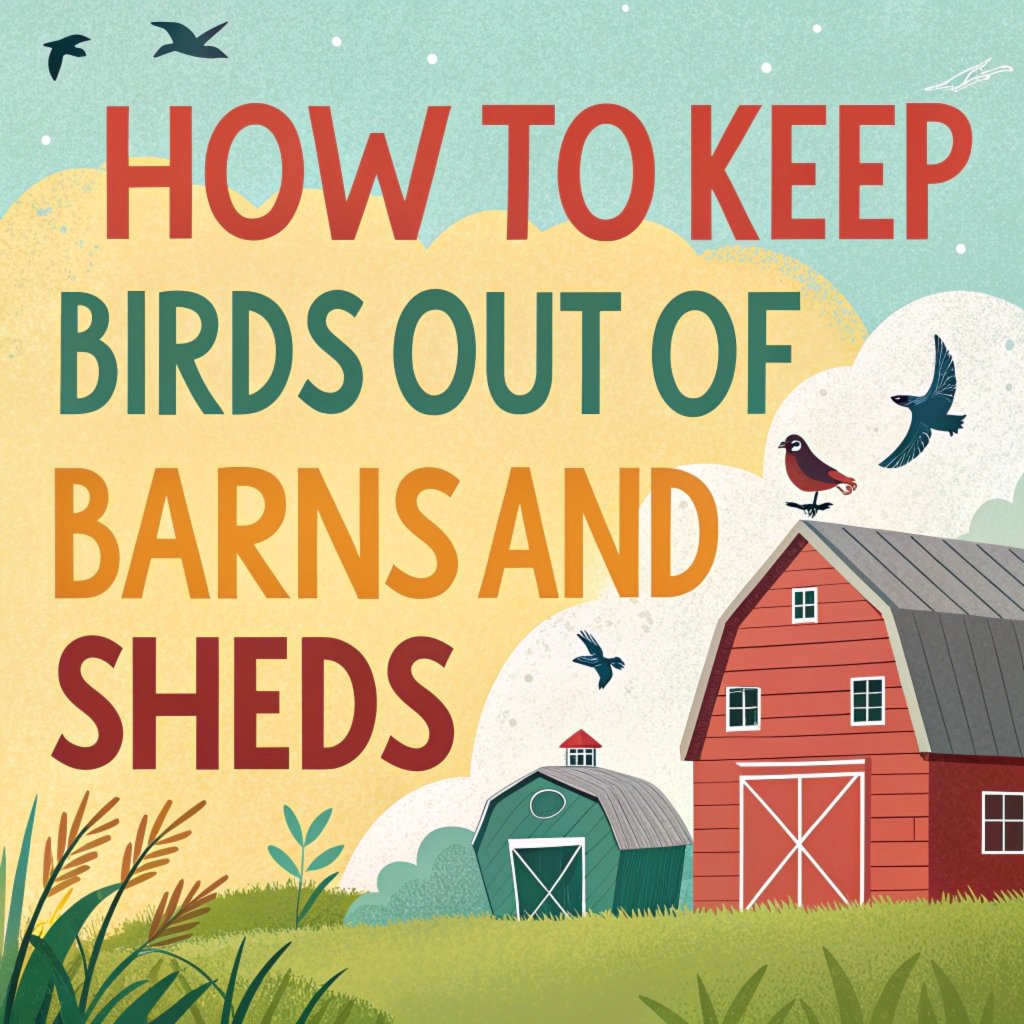
Key Takeaways
- Identify the Problem: Understand which bird species are causing issues to tailor your control methods effectively.
- Eliminate Attractants: Remove or secure food and water sources that draw birds to your structures.
- Seal Entry Points: Thoroughly inspect and block all potential access points larger than half an inch.
- Use Physical Deterrents: Install bird spikes, netting, or slanted boards to prevent birds from landing and roosting.
- Implement Visual and Sound Deterrents: Utilize predator decoys, reflective objects, and ultrasonic devices to scare birds away.
- Apply Chemical Repellents: Use non-toxic, biodegradable repellents to make surfaces unpleasant for birds.
- Consider Professional Services: For persistent problems, professional bird control services can offer comprehensive solutions.
- Maintain Cleanliness: Regular cleaning and removal of bird droppings is crucial for long-term control.
- Create Alternative Habitats: Redirect birds to more desirable areas away from your structures.
- Educate Staff: Ensure all personnel are aware of and follow bird control protocols.
- Stay Legal and Ethical: Be mindful of wildlife protection laws and prioritize humane control methods.
- Evaluate and Adjust: Regularly assess the effectiveness of your strategies and be prepared to modify your approach.
- Conduct Regular Inspections: Frequently check for signs of new bird activity or entry points.
- Combine Methods: Use a variety of techniques for the most effective bird control strategy.
- Be Patient and Persistent: Effective bird control often requires ongoing effort and adaptation over time.
By following these key strategies and maintaining a proactive approach, you can significantly reduce bird problems in your barns, sheds, and other structures, creating a safer and more hygienic environment for your operations.
Understanding the Bird Problem in Structures
Birds can become a significant nuisance when they enter barns, sheds, and other structures. Common bird species that tend to inhabit these spaces include swallows, starlings, pigeons, sparrows, doves, and barn owls.
These winged creatures often seek shelter, nesting sites, and food sources within these buildings.
Their presence can lead to various issues, such as damage to property, accumulation of droppings, and potential health risks.
Understanding the specific bird species causing problems is crucial for implementing effective control measures.
Each species has unique behaviors and preferences, which can inform the most suitable deterrent methods.
For instance, starlings and sparrows prefer nesting in small cavities, while pigeons may roost on open rafters. By identifying the target species, you can tailor your approach to address their particular habits and effectively keep them out of your structures.
Eliminating Attractants: Food and Water Sources

One of the primary reasons birds are drawn to barns and other structures is the abundance of food and water. To discourage their presence, it’s essential to eliminate these attractants.
Start by storing all grains, seeds, and animal feed in bird-proof containers with tight-fitting lids. Clean up any spilled food immediately to prevent birds from foraging.
Maintain water sources carefully. Adjust livestock waterers so that the water level is deep enough to prevent birds from standing in it but shallow enough that they can’t perch on the edge to drink.
Turn off unnecessary fountains or other water features that might attract birds. By limiting access to food and water, you can significantly reduce the appeal of your structures to pest birds.
Sealing Entry Points and Blocking Access
Preventing birds from entering your barn or shed is a crucial step in bird control. Inspect the structure thoroughly and seal all openings larger than half an inch.
Use materials such as wood, metal, glass, or wire mesh to block these entry points. Pay special attention to areas around vents, eaves, and broken windows.
For doorways that can’t be kept closed, consider hanging strips of heavy plastic vertically. These allow people and machinery to pass through while keeping birds out.
Additionally, cover the undersides of rafters with netting to exclude birds from potential roosting sites.
By blocking access points, you create a physical barrier that makes it difficult for birds to enter and establish nests within your structures.
Installing Physical Deterrents on Surfaces

Physical deterrents can be highly effective in preventing birds from landing and roosting on various surfaces of your barn or structure.
Bird spikes are a popular option for ledges, windowsills, and rooftop edges. These devices create an uneven surface that birds find uncomfortable to land on.
Available in both plastic and stainless steel, spikes provide constant coverage and are relatively easy to install.
Another effective deterrent is the use of slanted boards or metal sheets. Install these at a 45-degree angle or steeper on flat surfaces where birds tend to perch.
This angled approach makes it difficult for birds to find a stable footing, discouraging them from roosting. Additionally, consider applying bird gel or other sticky substances to surfaces.
These create an unpleasant texture that birds avoid, further deterring them from landing or nesting in unwanted areas.
Utilizing Visual Deterrents and Scare Tactics
Visual deterrents can be an effective and low-maintenance method to keep birds away from your structures.
Predator decoys, such as owl or hawk statues, can create the illusion of danger and deter birds from approaching. For best results, move these decoys regularly to prevent birds from becoming accustomed to their presence.
Reflective objects like mirrors, shiny tape, or metallic pinwheels can also be effective. The movement and light reflection from these items can disorient and frighten birds.
Additionally, consider using flash tape – brightly colored, metallic ribbons that you can attach to high posts or branches.
The movement and reflection of these ribbons in the wind can startle birds and discourage them from entering the area.
Implementing Sound-Based Deterrent Systems
Sound-based deterrents can be highly effective in keeping birds away from your structures. Ultrasonic devices emit high-frequency sounds that are irritating to birds but generally inaudible to humans.
These devices can cover large areas and are particularly useful in semi-enclosed spaces where sound waves can reflect off surfaces.
Another option is the use of bird distress calls or predator sounds. These audio deterrents mimic the sounds of birds in distress or their natural predators, creating an environment that feels unsafe for pest birds.
It’s important to vary the sounds and patterns regularly to prevent birds from becoming accustomed to them. Some advanced systems even use random patterns and combinations of sounds to maintain effectiveness over time.
Using Netting and Exclusion Techniques
Bird netting is a highly effective method for keeping birds out of semi-enclosed spaces and large open areas.
This physical barrier prevents birds from entering while still allowing light and air to pass through.
Heavy-duty netting is ideal for long-term use in barns and sheds, while lighter options may be suitable for temporary protection of specific areas.
When installing netting, ensure it is properly secured to prevent birds from finding ways around or under it. Pay special attention to corners and edges, as these are common entry points.
For larger structures, professional installation may be necessary to ensure proper coverage and tension.
Netting can be particularly effective in protecting rafters, open doorways, and other areas where birds frequently enter or nest.
Applying Chemical Repellents and Taste Aversions
Chemical repellents and taste aversions can be useful tools in your bird control arsenal. These products work by making surfaces unpleasant for birds to land on or making food sources in the area taste bad.
Liquid repellents can be sprayed on various surfaces, creating an invisible barrier that birds find uncomfortable to touch or taste.
When using chemical repellents, opt for non-toxic, biodegradable formulas to ensure safety for other wildlife and the environment.
Some repellents use natural ingredients like grape extract or citrus oils, which are effective yet environmentally friendly.
Remember that these products may need to be reapplied periodically, especially after rain or heavy dew, to maintain their effectiveness.
Employing Professional Bird Control Services
For persistent or large-scale bird problems, professional bird control services can offer comprehensive solutions.
These experts have access to a wide range of tools and techniques, including some that may not be available to the general public.
They can conduct a thorough assessment of your property and develop a customized strategy to address your specific bird issues.
Professional services may include the installation of more complex deterrent systems, such as shock track systems or advanced sonic devices.
They can also provide ongoing maintenance and monitoring to ensure long-term effectiveness.
While this option may be more costly upfront, it can save time and resources in the long run, especially for large agricultural operations or commercial buildings facing significant bird problems.
Maintaining Cleanliness and Regular Inspections
Maintaining a clean environment is crucial in preventing bird infestations. Regularly clean up any spilled feed, remove standing water, and keep the area around your structures free of debris.
This reduces attractants that might draw birds to your property. Additionally, implement a routine for cleaning bird droppings, as these can attract more birds and pose health risks.
Conduct regular inspections of your structures to identify and address any new entry points or nesting attempts. Look for signs of bird activity, such as droppings, feathers, or nesting materials.
Promptly remove any nests you find (ensuring they are inactive and complying with relevant wildlife protection laws).
By staying vigilant and addressing issues early, you can prevent small problems from becoming larger infestations.
Creating Alternative Habitats Away from Structures
While deterring birds from your barns and sheds, consider creating alternative habitats to redirect them to more desirable areas.
This approach can be particularly effective for native bird species that you don’t want to eliminate entirely from your property.
Install birdhouses or nesting platforms in areas away from your structures to provide alternative nesting sites.
Plant trees or shrubs at a distance from your buildings to offer natural perching and nesting spots. You can also set up feeding stations in these areas to attract birds away from your structures.
By providing attractive alternatives, you can reduce the pressure on your buildings while still maintaining a bird-friendly environment on your property.
Educating Staff and Implementing Best Practices
Effective bird control requires a team effort, especially in larger agricultural or commercial settings.
Educate your staff about the importance of bird control and the specific measures you’re implementing.
Train them to identify signs of bird activity and to follow proper procedures for maintaining a bird-free environment.
Develop and implement best practices for daily operations that minimize bird attractants. This might include protocols for feed storage, waste management, and building maintenance.
Encourage staff to report any bird activity or potential entry points they notice. By fostering a culture of awareness and proactive management, you can significantly enhance the effectiveness of your bird control efforts.
Addressing Legal and Ethical Considerations
When implementing bird control measures, it’s crucial to be aware of legal and ethical considerations.
Many bird species are protected under various wildlife laws, and certain control methods may be restricted or prohibited.
Research local regulations and obtain any necessary permits before implementing control measures, especially those involving trapping or relocation.
Prioritize humane methods that deter birds without causing harm. Avoid toxic substances or any methods that could injure birds or other wildlife. If you need to remove nests, ensure they are inactive and do so outside of breeding seasons.
By focusing on prevention and deterrence rather than elimination, you can effectively manage bird problems while respecting wildlife and adhering to legal requirements.
Evaluating and Adjusting Your Bird Control Strategy
Bird control is an ongoing process that requires regular evaluation and adjustment. Monitor the effectiveness of your implemented measures and be prepared to modify your approach as needed.
Different bird species may respond differently to various control methods, and their behaviors can change over time.
Keep a record of bird activity and the success rates of different control measures. This data can help you identify trends and adjust your strategy accordingly.
Be open to trying new methods or combining different approaches for better results.
Remember that effective bird control often requires a multi-faceted approach, and what works best may vary depending on the season, bird species, and specific characteristics of your structures.
Frequently Asked Questions
What are the most effective methods to keep birds out of barns?
The most effective methods include sealing entry points, using physical deterrents like spikes or netting, implementing visual and sound-based scare tactics, and maintaining a clean environment free of food and water attractants.
Are there any humane ways to deter birds from structures?
Yes, many humane methods exist, such as using ultrasonic devices, visual deterrents, and exclusion techniques like netting. These methods discourage birds without causing harm.
How often should I inspect my barn for bird activity?
Regular inspections, ideally weekly or bi-weekly, are recommended to catch any new bird activity early and maintain the effectiveness of your control measures.
Can I remove bird nests from my barn?
Removing inactive nests is generally acceptable, but be aware of wildlife protection laws. Active nests of many species are protected and should not be disturbed.
What should I do if birds have already established a presence in my barn?
Start by identifying entry points and sealing them. Then, implement a combination of deterrent methods and thoroughly clean the area to remove attractants. Professional help may be necessary for large infestations.

Hello, I’m Amelia White, the founder of birdsfanatic.com. As a lifelong bird enthusiast and spiritual seeker, I’ve always been fascinated by the mystical connections between birds and the human experience. On this site, I share my knowledge and insights into the symbolic meanings and spiritual significance of various bird species, exploring their roles in mythology, folklore, and cultural traditions. Join me on this journey into the world of birds, where we’ll discover the hidden wisdom and guidance that these magnificent creatures have to offer.

